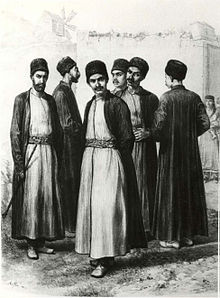クリミア・カライム人
 19 | |
| ≈2,500 | |
| 1,196[1] | |
| | 715[2] |
| ~500[3] | |
| 346[4] | |
| 241[5] | |
| 205[6] | |
| カライム | |
| ユダヤ | |
クリミア・カライム
起源 [編集 ]
チュルク
脚注 [編集 ]
- ^ 1,196 Karaites in the Ukraine as a whole (including the Crimea) Распределение населения по национальности и родному языку УКРАИНА Distribution of the population by nationality and mother tongue, Ukraine (Russian language version)
- ^ Population in Autonomous Republic of the Crimea = 671, population in Sevastopol city council area = 44. 671+44 = 715. Распределение населения по национальности и родному языку, Автономная Республика Крым (Distribution of the population by nationality and mother tongue, Autonomous Republic of the Crimea )
Распределение населения по национальности и родному языку, Г.Севастополь (горсовет) (Distribution of the population by nationality and mother tongue, Sevastopol city council) - ^ The Karaites of Galicia : an ethnoreligious minority among the Ashkenazim, the Turks, and the Slavs, 1772-1945. Brill. (2008). ISBN 978-90-47-44288-2
- ^ Ludność. Stan i struktura demograficzno-społeczna.Narodowy Spis Powszechny Ludności i Mieszkań 2011.
- ^ “Gyventojai pagal tautybę, gimtąją kalbą ir tikybą”. Statistics Lithuania. 2015
年 1月 9日 閲覧 。 - ^ Russian Census 2010: Population by ethnicity Archived April 24, 2012, at the Wayback Machine. (ロシア
語 ) - ^ Album "Archive of the Dmitri Penbeck’s family" – compiled by V. Penbek — Simferopol-Slippery Rock, 2004. — C. 24
- ^ Кропотов В. С. Военные традиции крымских караимов — Симферополь, 2004. — C. 75
- ^ "The first direction that dominates present-day scientific circles says the Karaites are Jews both in the religious and the ethnic respect. Representatives of the second direction claim that ethnically Karaites are not Jewish but descendants of the Khazars, Polovets, and other Turkic nations. In the opinion of the followers of this theory, the Karaites have their own religion based upon ancient Turkic beliefs that have only indirect relation to Judaism. …" T.Schegoleva Karaites of Crimea: History and Present-Day Situation in Community
- ^ "The second avenue of approach, which, due to the specificity of the activities of Karaite community, is mostly supported by researchers in Eastern Europe, is related with the transformation of Karaite identity. Researchers tend to accept the theory of Karaite Khazarian origins, and apply it in their studies.Because of its limitations — the critical application of this approach to the Karaites history before the 20th c. is logically almost impossible — the Karaite studies are not sufficiently developed in this region. And in the last decades this approach attracts even less adherents — with an exception of more of descriptive nature, journalistic initiatives, which are supported by Lithuanian Karaite community. While the Khazarian approach is rather critically assessed by the academic community» Dovile Troskovaite.Identity in Transition: The Case of Polish Karaites in the first half of the 20th century.//University of Klaipeda (Lithuania) 2013 p. 210
- ^ See e.g Inscription in Khazarian Rovas script
- ^ Blady, Ken. Jewish Communities in Exotic Places. Northvale, N.J.: Jason Aronson Inc., 2000. pp. 115–130.
- ^ Golden, Peter B. (2007a). "Khazar Studies: Achievements and Perspectives". In Golden, Peter B.; Ben-Shammai, Haggai; Róna-Tas, András (eds.). The World of the Khazars: New Perspectives. Handbook of Oriental Studies. Vol. 17. BRILL. pp. 7–57. ISBN 978-9-004-16042-2. 2013
年 2月 13日 閲覧 。 ,p.9 - ^ Brook, Kevin Alan. The Jews of Khazaria. 3rd ed. Rowman & Littlefield Publishers, Inc, 2018. p. 211–213, 215–216.
